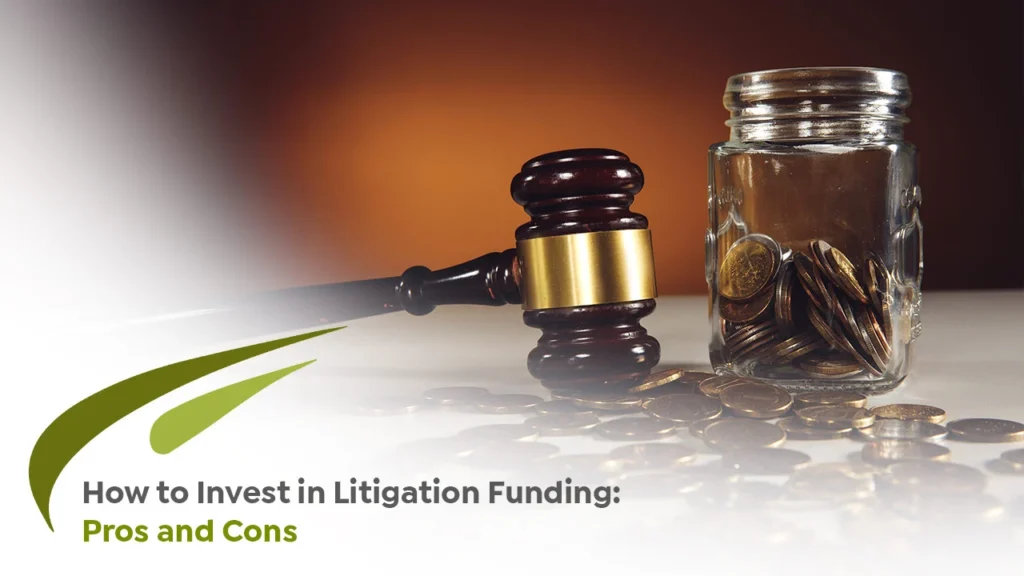Litigation funding, known as third-party litigation funding (TPLF), is an increasingly popular investment option.
It allows investors to participate in the financing of lawsuits and potentially earn high returns. However, like any investment, litigation funding comes with its own set of advantages and disadvantages.
This article will explore how to invest in litigation funding, clarifying both sides of the coin, and providing the information you need to decide if litigation funding is right for your portfolio.
What is Litigation Funding?
In simple terms, litigation funding involves a third-party investor (the funder) providing financial backing to a plaintiff (the party bringing the lawsuit) in exchange for a share of the potential settlement or judgment.
This allows plaintiffs, who might not otherwise have the resources, to pursue their claims.
Here’s how it typically works:
- A plaintiff with a strong case approaches a litigation funding company.
- The funding company assesses the merits of the case and calculates the potential risks and rewards.
- If the case is deemed promising, the funding company agrees to cover the legal costs associated with the lawsuit, such as attorney fees, expert witness fees, and court filing fees.
- If the lawsuit is successful, the plaintiff receives a portion of the settlement or judgment, and the funding company receives a predetermined percentage, typically much larger than the plaintiff’s share.
- If the lawsuit is unsuccessful, the funding company loses its investment, and the plaintiff owes nothing.
How to Invest in Litigation Funding?
- To Invest in litigation funding you should follow a structured process:
Research and Due Diligence:
- Understand the litigation finance market, including its regulatory framework and key players.
- Conduct thorough research on litigation funding providers, assessing their track record, expertise, and transparency.
Assessing Investment Opportunities:
- Evaluate potential cases based on their merits, potential settlement value, and associated risks.
- Consider diversifying your investment across multiple cases to mitigate risk.
Negotiation and Investment:
- Negotiate terms with the litigation funding provider, including the funding amount, share of proceeds, and recourse in case of unsuccessful litigation.
- Execute investment agreements and monitor the progress of funded cases.
Litigation Funding Pros:
Litigation funding offers investors a unique opportunity to diversify their portfolios while potentially gaining substantial rewards.
Here are some of the key pros associated with investing in litigation funding:
Diversification:
- Invest in litigation funds provides an opportunity to diversify investment portfolios beyond traditional asset classes like stocks and bonds.
- Offers exposure to alternative assets with potentially low correlation to broader market movements.
Potentially High Returns:
- Successful litigation outcomes can yield significant returns, often surpassing initial investment amounts.
- Investing in litigation funds Allows investors to participate in legal proceedings without directly engaging in litigation.
Risk Mitigation:
- Shifts the financial risk of litigation from the plaintiff to the litigation funder.
- Provides access to legal expertise and resources to assess the viability of cases and mitigate downside risks.
Access to Justice:
- Enables plaintiffs with meritorious claims but limited financial resources to pursue legal action against deep-pocketed defendants.
- Promotes fairness and equality in the legal system by leveling the playing field for underprivileged litigants.
Litigation Funding Cons:
While litigation funding presents compelling opportunities, it’s essential to consider the potential drawbacks.
Here are some of the key cons associated with invest in litigation funding:
Uncertain Outcomes:
- Litigation is inherently unpredictable, with outcomes dependent on various factors such as legal arguments, evidence, and judicial discretion.
- Not all cases result in favourable settlements or judgments, leading to the potential loss of invested capital.
Lack of Control:
- Investors have limited control over the litigation process, including case strategy, settlement negotiations, and litigation expenses.
- Dependency on legal professionals and the judicial system introduces operational and execution risks.
Ethical Considerations:
- Funding lawsuits might encourage unnecessary legal fights or make them last longer just for money.
- Raises concerns about conflicts of interest, confidentiality breaches, and interference with attorney-client relationships.
Regulatory Uncertainty:
- The legal and regulatory landscape surrounding litigation funding varies by jurisdiction, leading to potential compliance challenges and regulatory scrutiny.
- Changing regulations or judicial interpretations could impact the viability and profitability of investing in litigation funds.
Litigation Funding is Not a Loan
It’s important to highlight that to invest in litigation funding differs significantly from traditional loans in several key aspects.
- Non-Recourse Financing: Litigation funding typically involves non-recourse financing, meaning the investor’s recourse is limited to the proceeds of the funded case.
- Risk Sharing: Unlike loans, where repayment depends on the borrower’s creditworthiness, litigation funding shares the risk of litigation outcomes between the investor and the plaintiff.
- No Repayment Obligation: In the event of an unsuccessful lawsuit, the plaintiff is not obligated to repay the litigation funder, mitigating the financial risk for the plaintiff.
Invest in Litigation Funding with FreshStart UK: Empowering Access to Justice
FreshStart UK positions as a facilitator for both parties involved in litigation funding.
As a leading litigation funding provider, Freshstart UK offers tailored solutions to plaintiffs seeking to pursue meritorious claims but facing financial constraints.
Through its expertise and resources, Freshstart UK enables litigants to level the playing field against well-funded opponents, ensuring that financial barriers do not limit justice.
By offering flexible funding arrangements and diligent case evaluation, Freshstart UK empowers clients to navigate the complexities of litigation with confidence, ultimately enhancing access to justice and promoting fairness in the legal system.
The best choice is to invest in Litigation funding with FreshStart UK.
Conclusion
Investing in litigation funds offers a unique opportunity to diversify portfolios, potentially achieve high returns, and support access to justice.
However, it’s essential to weigh the pros and cons carefully, conduct thorough due diligence, and seek professional advice to navigate the complexities of this alternative investment avenue effectively.
While litigation funding presents compelling opportunities, it’s crucial to consider potential drawbacks such as uncertain outcomes, lack of control, ethical considerations, and regulatory uncertainties.
Despite these challenges, the role of companies like Freshstart UK in providing accessible and strategic financial support underscores the importance of empowering individuals and businesses to pursue legal claims without financial constraints.
By offering tailored solutions and diligent case evaluation, Freshstart UK exemplifies how litigation funding can enhance access to justice and promote fairness in the legal system. With the right approach and risk management strategies, How to Invest in Litigation Funding can be a valuable addition to an investor’s toolkit, contributing to financial objectives and societal impact.








